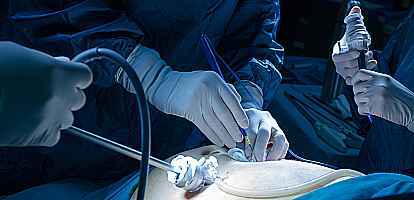Extracorporeal Shockwave Lithotripsy (ESWL)
Introduction
Extracorporeal shockwave lithotripsy (ESWL) is a minimally invasive procedure for treating kidney stones. Shock waves are applied externally targeted at the stone, to fragment it within the urinary tract. The patient will then need to drink lots of water and pass the fragments over the following weeks. The success rate is 70% to 90% of stone passage within 3 months of treatment.
It is considered less invasive compared to other treatment options such as kidney or ureteric laser stone surgery, or percutaneous nephrolithotomy (PCNL). However, not all stones can be treated with this.
Indications
- Effective for smaller stones (<2cm), ideally in the mid or upper kidney, or upper ureter.
- Not as effective if the stone is big (>2.5cm) or located in the lower part of the kidney, as these have a lower chance of passing spontaneously after fragmentation.
- Not effective if the stone is very hard (e.g., cystine stone).
- Not suitable for patients with a bleeding disorder or those who cannot stop blood thinning medications.
- Not effective in very obese patients.
- Not effective if there is a known narrowing or scarring below the stone in the urinary tract.
Preoperative Instructions
If you are taking blood thinners or certain newer diabetic medications, please inform your doctor as these may have to be stopped before the surgery.
If you are having a general anaesthetic or IV sedation, you will need to fast for at least 6 hours before the surgery.
Your doctor may require you to have blood tests or a urine test prior to the surgery.
Inform your doctor if you have a cardiac pacemaker, as certain types need to have the programming modified.
See preparing for surgery, for more detailed instructions.
Procedure
It is done under general anaesthesia or IV sedation. Intravenous antibiotics are given. It takes about 45 – 60 minutes. There is no skin incision involved.
Sometimes a stent is pre-inserted (JJ stent insertion) to prevent pain, when it is anticipated the stone fragments can line up in the ureter to cause obstruction (steinstrasse).
The patient is positioned on top of a soft gel-like cushion, through which the shockwaves pass. Using X-ray or ultrasound, the stone is visualised and targeted. Up to 4000 shockwaves may be used in one session.
Postoperative Instructions
This is usually a day procedure and the patient can go home after the surgery.
If a general anaesthetic or IV sedation is given, it is advisable that someone else drive you home. Do not undertake any of the following activities for 24 hours: driving a car, operating machinery, handling hot cooking instruments, or drinking alcohol.
You may get mild bleeding in the urine in the first few days. If you get heavy bleeding with large blood clots, inform your doctor.
Watch for signs of urine infection such as persistent burning, foul-smelling urine, cloudy urine, and urinary frequency. This may be from a release of bacteria trapped in the stone, or from the blockage of urine from stone fragments in the ureter. Antibiotics are given during the surgery and some patients may be discharged on oral antibiotics to prevent this. See your GP if this happens to get the urine tested in case you need more or different antibiotics.
You may get mild bruising or grazing of the skin of the back where the shockwaves go through. Take your pain medication as indicated.
If you get colicky pain, it may be from the stone fragments passing down the ureter. Uncommonly, if the fragments line up and get stuck, the pain will be prolonged and severe. Inform your doctor as some patients may need another procedure to remove these fragments.
Most patients can resume normal activities or go back to work within 1 to 3 days after the procedure.
Attend the post-op appointment for your doctor to check your progress. Usually, another ultrasound or X-ray test will be done around 3 months after the procedure to check if all the fragments have passed.
Risks
General risks:
- Anaesthetic risks such as heart or lung problems.
- Bleeding – it is uncommon to need a blood transfusion for this surgery.
- Clots in the legs (DVT) or pulmonary emboli.
- Chest infection, urinary tract infection.
- Allergic reactions (e.g., to dressings, drugs etc.) – inform us if you have any known allergies.
- Risk of death is a very rare complication that may arise from any surgery or anaesthetic. Modern medicine and anaesthesia have made this extremely rare. The risk varies with each individual’s general health conditions and the complexity of the surgery. The ESWL surgery is not considered to be a major surgery.
Specific risks:
- Mild skin bruising or grazing (common, 10% to 50%).
- Incomplete clearance of stone – some patients may require another procedure to fully clear all the fragments.
- Severe bleeding causing loss of kidney (very rare).
- Abnormal heart rhythm during the procedure (uncommon).
- Injury to nearby organ (e.g., spleen, liver, pancreas, lung, bowel). This is very rare.
Treatment Alternatives
See kidney stones, for other treatment alternatives.

